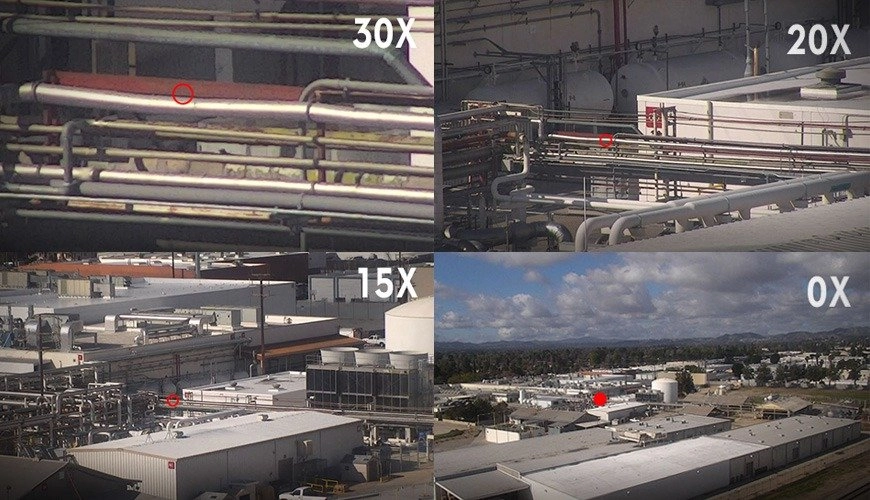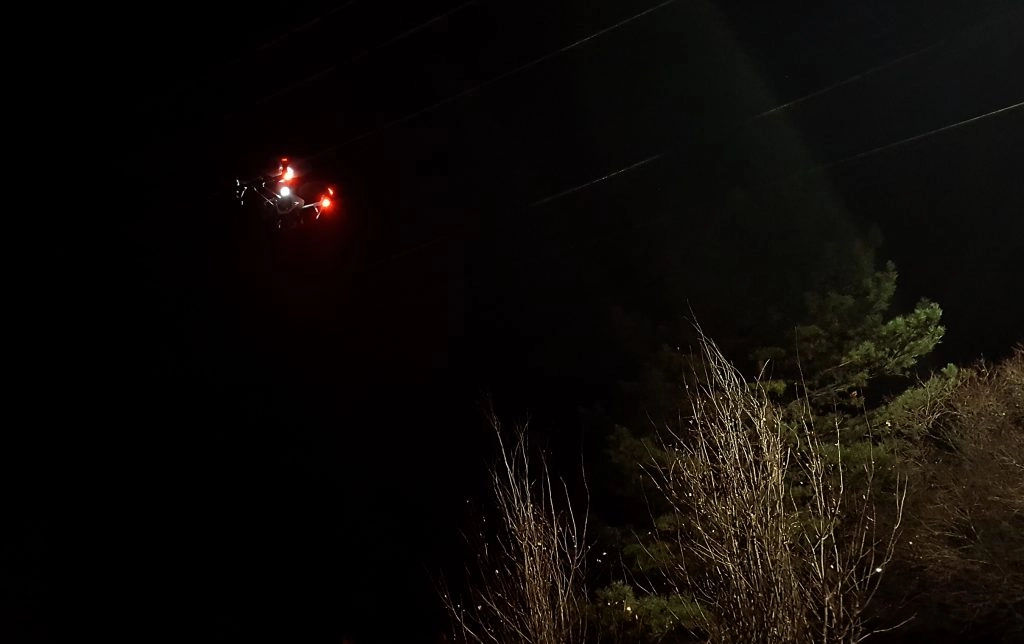With the Federal Aviation Administration (FAA) easing drone ownership and flying regulations, it’s now the norm to see drones flying often. Even there are drones at night
The various industries, including filmmaking, mapping, surveying, photography, and even recreation, use drones. What’s worrying is when you spot drones at night.
Since they aren’t easy to spot, you can’t help but wonder if they’re spying on you or sent to conduct other malicious activities.
The latest FAA rules allow drones to fly at night. So if you’re in the United States, and happen to see a drone in your neighborhood, probably a filmmaker wants to get some night shots. Law Enforcement officers are also using drones for aerial surveillance, which could happen during the day or at night.
Please keep reading to find out more about drones flying at night.
Why Drones At Night?
Last year, citizens in eastern Colorado spotted drones at night over their skies for more than 90 occurrences. The Denver Post reported that the drones flew in groups and with a specific formation in some instances.
While there are investigations on who owned those drones, the big question was why they passed them at night. There are several reasons why drones could be flying over your compound at night.
You NEED To Know This BEFORE You Fly a Drone at Night!!
Drones have wide application in the following:
CLICK HERE Times have changed. Drones have moved from only military use to our everyday life. As highlighted above, there are many pluses to the application of drones. Drones can save lives or end them. ( https://www.remoteflyer.com/12-best-drone-apps-2021-review/ ) The main point of concern is the violation of privacy rights through pervasive surveillance. Pervasive surveillance is the process of tracking and cataloging people’s movements for a long time. By using drones, the government can keep an eye on you when you are exercising your constitutional rights of freedom of movement and association. The government will monitor you while protesting or in political gatherings. The powerful and sophisticated drone models have better surveillance abilities than human-crewed aerial vehicles. For example, the Inspire drone fitted with a DJI Zenmuse Z30 camera captures clear images of objects more than four miles from its location. Such drones can track a person’s movement for long, identify vehicle details such as the number plates and occupants, facial recognition, and attack suspects using missiles onboard. Civil rights groups in many countries have been fighting the use of drones for surveillance. They have been arguing that the metadata collected using drones may open a way to harm the victims. And it’s a valid argument. That is why in several states in the USA, police need to have a warranty to observe you with a drone. Should you be worried about drones at night? Yes! With today’s drones’ capabilities, a terrorist will use them to collect crucial information about you and use them to bomb your place. As drones are becoming more popular, more and more players are using them, and there are even many interest-based organizations and associations that hold their own flying events. The issue of drones flying in the sky near you is a scary one. It gets even worse with news reports of swarms of drones spotted flying at night. But since no reports on your area exist, you comfort yourself. I wouldn’t be so sure just yet. Below are several methods you can use to make out if drones fly around your area at night. All drones have a system of lights installed. The lights are for navigation and preventing collisions with other drones. The color and regularity of these lights vary, further helping you mark out if a moving object is a drone. Navigation lights are mainly red, white, or green. There is no regulation on using a single color or a mix. Whereas they are visible at night, not all drones have them. Hence, they may not be so much helpful in your spotting endeavors. As a regulation, all drones have anti-collision lights. These lights are straightforward to identify. They are either red or white. So sometimes, that floating object looking like a star in the sky over you may be a drone. How do you differentiate that floating light-emitting thing from a star? Use the other methods below. Drones use several propellers to fly. Those propellers make a buzzing sound. Does that floating object with a blinking or solid light have a buzzing sound? Whereas newer models of drones are quieter, that buzzing always betrays them. Drones industry is the latest development in air travel. There are hot debates everywhere on the regulations and security side of the new products. Before everyone gets to an agreement, an aviation security company DeTech Inc has developed an android app that instantly turns your phone into a drone sensor. Your Android phone and drones have something in common. They use Wi-Fi signals to communicate. Therefore, your phone notifies you of this software when a drone gets within a half-mile of it. However, this program is only constrained to detecting unencrypted wifi signals, making it ineffective with newer versions of drones that use encrypted wifi signals or none at all. The program is free to use. Hence having it is an advantage. An FAA regulation is that all drones have anti-collision lights, especially if they fly at night. With activity seeing night vision cameras, you can easily spot drones at night around your property. The advantage is you don’t need any technical skills or equipment to install these cameras on your property. Most are plug-and-play devices. These sensors are inexpensive and the perfect night watchmen for drones. These sensors use a simple technique. They emit microwaves that objects within their field of view deflect back. A moving object such as a drone changes the deflected microwaves’ wavelength due to the Doppler’s effect. The distorted wavelength sets off the sensor. These sensors go for less than 30 dollars on Amazon. If you feel very threatened by drones at night over your property, you can install a radar detection system. These systems detect incoming drones to your property and make out their make and model. You may have to verify if your state allows for the installation of such systems. Drones are powerful surveillance gadgets. More sophisticated models cannot only record but also facially identify humans and take suspects out. Therefore, the debate on regulations to control privacy infringement is not dying soon. Further, it is not an easy way to tell why a drone is flying in the sky near you, especially at night. Then, what are the steps you should take when you become suspicious of a drone over your property? First, make a point of speaking to the operator. Unless they are military-grade drones or police surveillance drones, professional drone operators have a legal obligation to keep an eye on their drones. Hence, there is a high possibility the operator of that drone over your property is within your vicinity. Talk to them to establish their objective of using a drone in your area. They may be performing a property inspection or simply taking photos for fun, without any focus on you. What if you are sure the drone was observing you and can’t find the operator? t’s time to learn your state or town drone legislation. Explore all the laws that concern privacy protection as well as hacking and harassment. Check on the regulations regarding noise within your locality if the drone sound is a problem. Once you have an angle to criticize the flying of drones in your area, it’s time for the next step. Related Article: Create documentation of the issue. Be sure to capture the date and time you spotted the drone; if you can see any writings on the drone, record. Additionally, take a photo of the drone if possible, and do a thorough description of its physical properties. Finally, present your case to the police and FAA for further investigation and action. According to FAA, there are 868,804 registered drones in the United States alone. When you add the drones in other countries with heavy drone use like the United Kingdom, China, and India, that number soars. Now with the FAA permitting Amazon Prime Air to join FedEx and UPS in live testing drone deliveries, drone flight will triple soon. This permission should be a concern to you already because the daily number of drone flights has surpassed the USA and the UK’s annual airplane flights. What are the regulators in different countries addressing drones’ privacy and security issues flying at night over private property? In the USA, there have been positive signs of progress in regulating the use of drones. For instance, the FAA latest regulations require drones and their operators to have the following before flying the skies, especially at night: What’s more? Different states have enacted regulations to protect citizen privacy rights violations by law enforcers through pervasive surveillance. Most codes require law enforcement officers to have a warrant before using a drone on you or your property. And a warrant doesn’t come easy. The police must give sufficient reasons in the application before a judge issue one. To feel safer, check out the drone usage regulations in your country. Always be aware of the rights and privileges you have under the rules. Equally important, take the necessary actions when a drone operator oversteps their authority. Drones place immense power on the hands of the government and terrorists. The ability to collect and store private and sensitive data on people is detrimental to public safety if not checked. Many states in the USA passed regulations to monitor the use of crewless aerial vehicles recently. But privacy advocates have a point of concern. Source: Remoteflyer
Should You Get Concerned?

How to Spot a Drone at Night?
Watch Out for the Lights-

The Buzzing Sound-
Drone Detecting Android Apps-
Motion Detecting Night Vision Cameras-
Microwave Motion Sensors-
Radar Detection System-
What to Do if You Feel Unsafe?
Can You Fly a Drone at Night: Requirements to Fulfill?
Proposal By Privacy Advocates:
